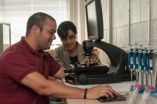(Press-News.org) WINSTON-SALEM, N.C. – Sept. 19, 2012 – A genetic mutation that occurred thousands of years ago might be the answer to how early humans were able to move from central Africa and across the continent in what has been called "the great expansion," according to new research from Wake Forest Baptist Medical Center.
By analyzing genetic sequence variation patterns in different populations around the world, three teams of scientists from Wake Forest Baptist, Johns Hopkins University School of Medicine and the University of Washington School of Medicine, Seattle, demonstrated that a critical genetic variant arose in a key gene cluster on chromosome 11, known as the fatty acid desaturase cluster or FADS, more than 85,000 years ago. This variation would have allowed early humans to convert plant-based polyunsaturated fatty acids (PUFAs) to brain PUFAs necessary for increased brain size, complexity and function. The FADS cluster plays a critical role in determining how effectively medium-chain PUFAs found in plants are converted to the long-chain PUFAs found in the brain.
This research is published online today in PLOS One.
Archeological and genetic studies suggest that homo sapiens appeared approximately 180,000 years ago, but stayed in one location around bodies of water in central Africa for almost 100,000 years. Senior author Floyd H. "Ski" Chilton, Ph.D., professor of physiology and pharmacology and director of the Center for Botanical Lipids and Inflammatory Disease Prevention at Wake Forest Baptist, and others have hypothesized that this location was critical, in part, because early humans needed large amounts of the long-chain PUFA docosahexaenoic acid (DHA), which is found in shellfish and fish, to support complex brain function.
"This may have kept early humans tethered to the water in central Africa where there was a constant food source of DHA," Chilton said. "There has been considerable debate on how early humans were able to obtain sufficient DHA necessary to maintain brain size and complexity. It's amazing to think we may have uncovered the region of genetic variation that arose about the time that early humans moved out of this central region in what has been called the 'great expansion.'"
Once this trait arose, the study shows that it was under intense selective pressure and thus rapidly spread throughout the population of the entire African continent. "The power of genetics continually impresses me, and I find it remarkable that we can make inferences about things that happened tens of thousands of years ago by studying patterns of genetic variation that exist in contemporary populations," said Joshua M. Akey, Ph.D., lead scientist at the University of Washington.
This conversion meant that early humans didn't have to rely on just one food source, fish, for brain growth and development. This may have been particularly important because the genetic variant arose before organized hunting and fishing could have provided more reliable sources of long-chain PUFAs, Akey said.
To investigate the evolutionary forces shaping patterns of variation in the FADS gene cluster in geographically diverse populations, the researchers analyzed 1,092 individuals representing 15 different human populations that were sequenced as part of the 1000 Genome Project and 1,043 individuals from 52 populations from the Human Genome Diversity Panel database. They focused on the FADS cluster because they knew those genes code for the enzymatic steps in long-chain PUFA synthesis that are the least efficient.
Chilton said the findings were possible because of the collaboration of internationally recognized scientists from three distinct and diverse disciplines – fatty acid biochemistry (Wake Forest Baptist), statistical genetics (Johns Hopkins) and population genetics (University of Washington). This new information builds on Chilton's 2011 research findings published in BMC Genetics that showed how people of African descent have a much higher frequency of the gene variants that convert plant-based medium-chain omega-6 PUFAs found in cooking oils and processed foods to long-chain PUFAs that cause inflammation. Compared to Caucasians, African Americans in the United States have much higher rates of hypertension, type 2 diabetes, stroke, coronary heart disease and certain types of cancer. "The current observation provides another important clue as to why diverse racial and ethnic populations likely respond differently to the modern western diet," Chilton said.
###
This research was supported by National Institutes of Health grants, P50 AT002782 and a Clinical and Translational Science Award grant to The Johns Hopkins Medical Institutions. Additional support was received from the Wake Forest Health Sciences Center for Public Health Genomics. Additional support came from the Mary Beryl Patch Turnbull Scholar Program and the MOSAIC initiative of Johns Hopkins University.
Chilton has a financial interest in and is a consultant for Gene Smart Health. His potential conflict of interest is being institutionally managed by Wake Forest Baptist and outside sponsors, as appropriate. No other authors have a conflict of interest.
First author is Rasika Mathias, Sc.D, assistant professor of medicine and epidemiology, Johns Hopkins; contributing authors include Hannah C. Ainsworth and Susan Sergeant, both of Wake Forest Baptist; Wenqing Fu, U of W; Dara G. Torgerson, University of California San Francisco; and Ingo Ruczinski and Kathleen C. Barnes of Johns Hopkins.
Genetic mutation may have allowed early humans to migrate throughout Africa, research says
2012-09-20
ELSE PRESS RELEASES FROM THIS DATE:
Clemson psychology professor conducts sleep research at Vienna university
2012-09-20
CLEMSON — Clemson University psychology professor June Pilcher returned recently from Austria, where she worked with University of Vienna researchers to study ways college students' sleep habits affect how they function socially.
Pilcher received a Fulbright-Freud Award to work with the Social, Cognitive, Affective and Neuroscience Unit (SCAN) at the University of Vienna. She also worked with the Sigmund Freud Museum, giving a series of talks and lectures.
Pilcher participated in research with the university's SCAN unit, a center that conducts research in the fields ...
Satellite sees post-Tropical Cyclone Lane fizzle in a blanket of low clouds
2012-09-20
Former Hurricane Lane has fizzled and its remnant circulation was spotted in a blanket of low clouds in the Eastern Pacific Ocean.
NOAA's GOES-15 satellite sits in a fixed orbit over the western U.S. and captures continuous visible and infrared imagery of the western U.S. and the Eastern Pacific Ocean. On Sept. 19 at 11:45 a.m. EDT, GOES-15 captured a visible image of post-tropical Lane's remnants that appear as a small circulation center. The center was located over 1,000 miles from Baja California in an extensive field of stratocumulus clouds. Stratocumulus clouds are ...
Evolution is as complicated as 1-2-3
2012-09-20
EAST LANSING, Mich. — A team of researchers at Michigan State University has documented the step-by-step process in which organisms evolve new functions.
The results, published in the current issue of Nature, are revealed through an in-depth, genomics-based analysis that decodes how E. coli bacteria figured out how to supplement a traditional diet of glucose with an extra course of citrate.
"It's pretty nifty to see a new biological function evolve," said Zachary Blount, postdoctoral researcher in MSU's BEACON Center for the Study of Evolution in Action. "The first ...
Study shows how consumers shift expectations and goals
2012-09-20
NEW YORK - September 19, 2012 - Sally and Harry are about to invest in their company's 401(k) plan. Sally chooses the best performing mutual fund, which has high risks but boasts a 25 percent year-to-date return. Harry, after considering the tradeoffs between risks and rewards, opts for a lower performing fund with an 8 percent year-to-date return. When they receive their next quarterly performance reports, both Sally and Harry discover that their funds have met their initial expectations. Are they satisfied? If not, why? And how could their levels of satisfaction be improved?
One ...
Using a laser to 'see' the smallest world
2012-09-20
(Santa Barbara, Calif.) –– A multi-university team has employed a high-powered laser based at UC Santa Barbara to dramatically improve one of the tools scientists use to study the world at the atomic level. The team used their amped-up electron paramagnetic resonance (EPR) spectrometer to study the electron spin of free radicals and nitrogen atoms trapped inside a diamond.
The improvement will pull back the veil that shrouds the molecular world, allowing scientists to study tiny molecules at a high resolution.
The team, which includes researchers from UCSB, University ...
UGA researchers boost efficacy of drugs by using nanoparticles to target 'powerhouse of cells'
2012-09-20
Athens, Ga. - Nanoparticles have shown great promise in the targeted delivery of drugs to cells, but researchers at the University of Georgia have refined the drug delivery process further by using nanoparticles to deliver drugs to a specific organelle within cells.
By targeting mitochondria, often called "the powerhouse of cells," the researchers increased the effectiveness of mitochondria-acting therapeutics used to treat cancer, Alzheimer's disease and obesity in studies conducted with cultured cells.
"The mitochondrion is a complex organelle that is very difficult ...
Johns Hopkins astrophysicist spies ultra-distant galaxy amidst cosmic 'dark ages'
2012-09-20
With the combined power of NASA's Spitzer and Hubble space telescopes as well as a cosmic magnification effect, a team of astronomers led by Wei Zheng of The Johns Hopkins University has spotted what could be the most distant galaxy ever detected.
Light from the young galaxy captured by the orbiting observatories shone forth when the 13.7-billion-year-old universe was just 500 million years old.
The far-off galaxy existed within an important era when the universe began to transit from the so-called "Dark Ages." During this period, the universe went from a dark, starless ...
The 'slippery slope to slime': Overgrown algae causing coral reef declines
2012-09-20
CORVALLIS, Ore. – Researchers at Oregon State University for the first time have confirmed some of the mechanisms by which overfishing and nitrate pollution can help destroy coral reefs – it appears they allow an overgrowth of algae that can bring with it unwanted pathogens, choke off oxygen and disrupt helpful bacteria.
These "macroalgae," or large algal species, are big enough to essentially smother corals. They can get out of control when sewage increases nitrate levels, feeds the algae, and some of the large fish that are most effective at reducing the algal buildup ...
The key to cooperation? Think fast
2012-09-20
It's an age old question: Why do we do good? What makes people sometimes willing to put "We" ahead of "Me?" Perhaps our first impulse is to be selfish, and cooperation is all about reining in greed. Or maybe cooperation happens spontaneously, and too much thinking gets in the way.
Harvard scientists are getting closer to an answer, showing that people's first response is to cooperate and that stopping to think encourages selfishness.
David Rand, a Post-Doctoral Fellow in Psychology, Joshua Greene, the John and Ruth Hazel Associate Professor of the Social Sciences ...
New cranial neural crest cell line developed
2012-09-20
New Rochelle, NY, September 19, 2012-- Researchers have successfully developed a stable population of neural crest cells derived from mice that can be grown in large quantities in the laboratory and that demonstrates the potential to develop into many different cell types needed throughout the body. This powerful new research tool for understanding stem cell biology and human development and disease is described in an article published in Stem Cells and Development, a peer-reviewed journal from Mary Ann Liebert, Inc., publishers. The article is available free on the Stem ...






